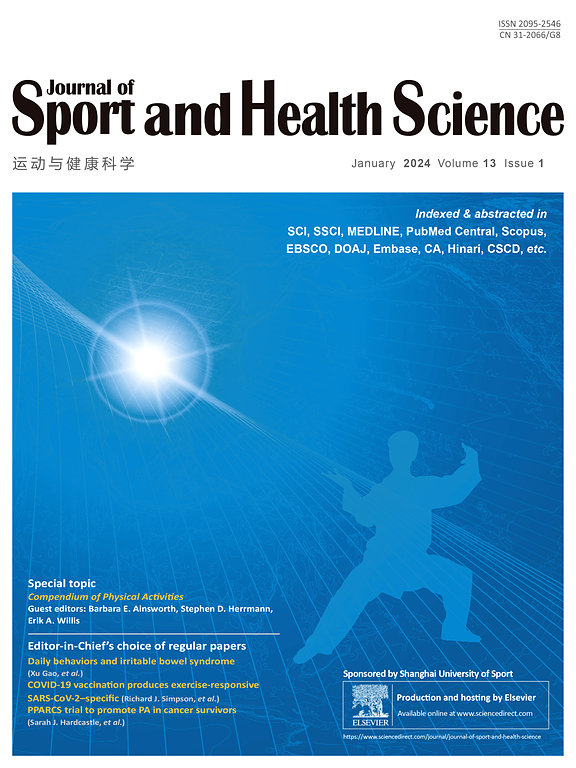Development of an accelerometer age- and sex-specific approach based on population-standardized values for physical activity surveillance: A proof of concept.
IF 9.7
1区 医学
Q1 HOSPITALITY, LEISURE, SPORT & TOURISM
引用次数: 0
Abstract
BACKGROUND A shift from self-reports to wearable sensors for global physical activity (PA) surveillance has been recommended. The conventional use of a generic cut-point to assess moderate-to-vigorous PA (MVPA) is problematic as these cut-points are often derived from non-representative samples under non-ecological laboratory conditions. This study aimed to develop age- and sex-specific (age-sex) cut-points for MVPA based on population-standardized values as a feasible approach to assess the adherence to PA guidelines and to investigate its associations with all-cause mortality. METHODS A total of 7601 participants (20-85+ years) were drawn from the 2003-2004 and 2005-2006 National Health and Nutrition Examination Surveys (NHANES). Minutes per week of MVPA were assessed with a hip-worn accelerometer. Counts per minute (CPM) were used to define an age- and sex-specific target intensity, representing the intensity each person should be able to reach based on their age and sex. Age- and sex-specific MVPA cut-points were defined as any activity above 40% of the target intensity. These population- and free-living-based age-sex specific cut-points overcome many of the limitations of the standard generic cut-point approach. For comparison, we also calculated MVPA with a generic cut-point of 1952 CPM. Both approaches were compared for assessing adherence to PA guidelines and association of MVPA with all-cause mortality (ascertained through December 2015). RESULTS Both approaches indicated that 37% of the sample met the 150+ min/week guideline. The generic cut-point approach showed a trend to inactivity with age, which was less pronounced using the age-sex cut-points. Overall mortality rates were comparable using generic cut-point (hazard ratio (HR) = 0.61, 95% confidence interval (95%CI): 0.50‒0.73) or age-sex cut-points (HR = 0.57, 95%CI: 0.50‒0.66) for the entire sample. The generic cut-point method revealed an age- and sex-related gap in the benefits of achieving 150+ min/week of MVPA, with older adults showing an 18% greater reduction in mortality rates than younger adults, and a larger difference in women than in men. This disparity disappeared when using age-sex-specific cut-points. CONCLUSION Our findings underscore the value of age-sex cut-points for global PA surveillance. MVPA defined with age-sex thresholds was associated with all-cause mortality and the dose‒response was similar for all ages and sexes. This aligns with the single recommendation of accumulating 150+ min/week MVPA for all adults, irrespective of age and sex. This study serves as a proof of concept to develop this methodology for PA surveillance over more advanced open-source acceleration metrics and other national and international cohorts.根据人口标准值开发针对不同年龄和性别的加速度计方法,用于体力活动监测:概念验证。
背景建议全球体力活动(PA)监测从自我报告转向可穿戴传感器。传统上使用通用切点来评估中强度体力活动(MVPA)是有问题的,因为这些切点通常是在非生态实验室条件下从非代表性样本中得出的。本研究旨在根据人群标准化值制定针对不同年龄和性别(年龄-性别)的 MVPA 切分点,以此作为一种可行的方法来评估 PA 指南的遵守情况,并研究其与全因死亡率的关系。每周进行 MVPA 的分钟数通过臀部佩戴的加速度计进行评估。每分钟计数(CPM)用于定义特定年龄和性别的目标强度,代表每个人根据其年龄和性别应达到的强度。针对不同年龄和性别的 MVPA 切点被定义为任何超过目标强度 40% 的活动。这些基于人口和自由生活的特定年龄和性别切点克服了标准通用切点方法的许多局限性。为了进行比较,我们还以 1952 CPM 的通用切点计算了 MVPA。结果两种方法都表明,37% 的样本符合 150 分钟/周以上的指导原则。通用切点法显示,随着年龄的增长,活动量呈下降趋势,而使用年龄-性别切点法时,这种趋势则不那么明显。使用通用切点法(危险比 (HR) = 0.61,95% 置信区间 (95%CI): 0.50-0.73)或年龄-性别切点法(HR = 0.57,95% 置信区间 (95%CI): 0.50-0.66)计算的整个样本的总死亡率相当。通用切点法显示,达到每周 150 分钟以上 MVPA 的益处存在年龄和性别差异,老年人的死亡率比年轻人降低 18%,女性的差异大于男性。我们的研究结果强调了年龄-性别切点在全球运动量监测中的价值。根据年龄-性别阈值定义的 MVPA 与全因死亡率相关,并且所有年龄和性别的剂量-反应相似。这与不分年龄和性别,所有成年人每周累积 150 分钟以上 MVPA 的单一建议相一致。这项研究证明了在更先进的开源加速度指标和其他国家及国际队列中开发这种方法进行运动量监测的概念。
本文章由计算机程序翻译,如有差异,请以英文原文为准。
求助全文
约1分钟内获得全文
求助全文
来源期刊

Journal of Sport and Health Science
SPORT SCIENCES-
CiteScore
18.30
自引率
1.70%
发文量
101
审稿时长
22 weeks
期刊介绍:
The Journal of Sport and Health Science (JSHS) is an international, multidisciplinary journal that aims to advance the fields of sport, exercise, physical activity, and health sciences. Published by Elsevier B.V. on behalf of Shanghai University of Sport, JSHS is dedicated to promoting original and impactful research, as well as topical reviews, editorials, opinions, and commentary papers.
With a focus on physical and mental health, injury and disease prevention, traditional Chinese exercise, and human performance, JSHS offers a platform for scholars and researchers to share their findings and contribute to the advancement of these fields. Our journal is peer-reviewed, ensuring that all published works meet the highest academic standards.
Supported by a carefully selected international editorial board, JSHS upholds impeccable integrity and provides an efficient publication platform. We invite submissions from scholars and researchers worldwide, and we are committed to disseminating insightful and influential research in the field of sport and health science.
 求助内容:
求助内容: 应助结果提醒方式:
应助结果提醒方式:


